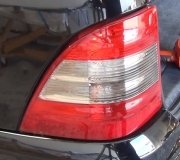The Engine Computer detected a defect and set a diagnostic fault code to indicate the circuit or system that needs further diagnosis, or the unacceptable operating condition. Since the defect could adversely affect emissions, it also turned on the Check Engine light. Disconnecting the negative battery cable can't possibly fix a defect, so that is not the answer. Further, that was very bad advice from a parts salesman because a lot of cars have computers that will lock up when doing that and will require a tow to the dealer to have them unlocked. With some car brands like BMW and VW, that can easily be over a $1000.00 repair, even from simply trying to replace a bad battery yourself.
An oil change is also not the answer. If waiting too long to have that done would cause a warning light to turn on, 90 percent of the cars on the road would have a light on. The light they referred to that they reset is the "Oil life remaining" message or the "Change oil soon" message that is found on a lot of newer cars today. Those are reminder messages that are totally different than warning lights. The computers that generate those messages have no way of knowing an oil change was performed, so someone has to manually reset it so it can start the new countdown. That is what they reset, when they can figure out the procedure. Some of them are pretty bizarre and not customer-friendly.
A $100.00 "machine" is just an inexpensive fault code reader. The people at many auto parts stores use them to read codes for customers for free, but their goal is to do what they do best, . . . sell parts. It is important to understand those fault codes never ever say to replace a part or that one is bad. The codes only indicate the circuit or system that needs further diagnosis, or the unacceptable operating condition. When a sensor or other part is referenced in a fault code, it is the cause of that code only about half of the time. First your mechanic must rule out wiring and connector terminal problems, and mechanical problems associated with that part, before potentially wasting your money on a part that isn't needed.
Most of those simple code readers only read fault codes in the Engine Computer. Some of the more expensive ones now can read codes in Anti-lock Brake and Air Bag Computers, but there can be four dozen other computers on a 2014 model. You need to visit a mechanic with a scanner that can access all those other computers to see which one detected the problem and set the fault code. Once the code numbers are known, post them in your reply, and you can go here to see the definitions:
https://www.2carpros.com/trouble_codes/obd2/p1100
or I can interpret them for you. Just about every independent repair shop has at least one scanner that is updated to work on the latest car models, so you don't necessarily have to go to the dealer. Reading the codes usually takes less than 15 minutes once the scanner is connected and communicating with the car. Someone should give you an idea of the typical things that could be responsible, and the best course of action. If you don't trust their recommendation, any other shop should be able to verify it by just knowing the code numbers, although a lot of those codes can be rather vague. Often some preliminary diagnosis must be done before a better dollar estimate can be given.
Wednesday, February 27th, 2019 AT 4:10 PM


